Business Environment and Firm Performance Analysis
VerifiedAdded on 2020/10/05
|14
|4689
|289
AI Summary
This assignment requires students to analyze the relationship between business environment and firm performance. It involves examining the impact of the home country on a firm's global strategy and the alignment of business enterprise architectures. Students will also explore how business environment reforms affect new firm registration and the strategic fit between innovation strategies and business environment in delivering business performance.
Contribute Materials
Your contribution can guide someone’s learning journey. Share your
documents today.
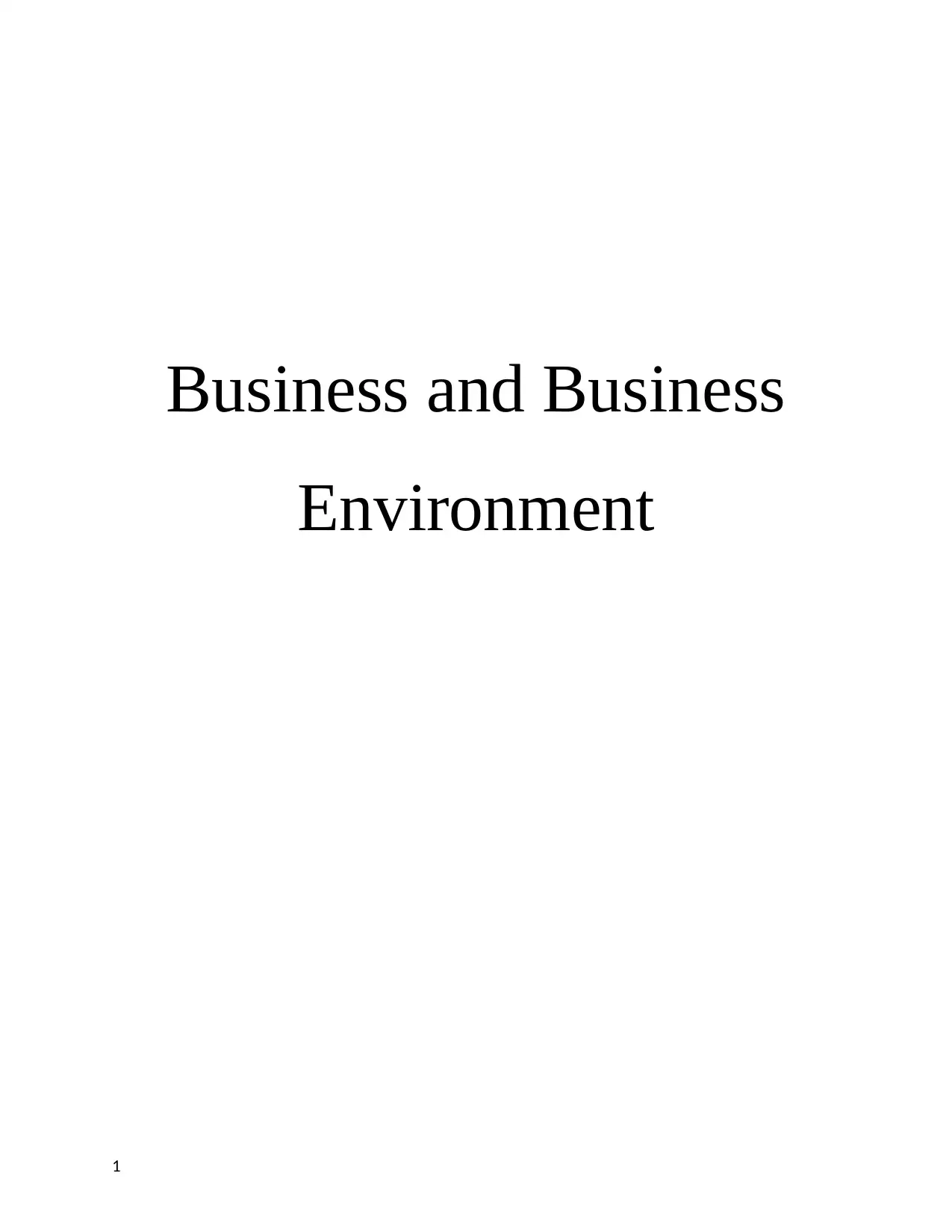
Business and Business
Environment
1
Environment
1
Secure Best Marks with AI Grader
Need help grading? Try our AI Grader for instant feedback on your assignments.
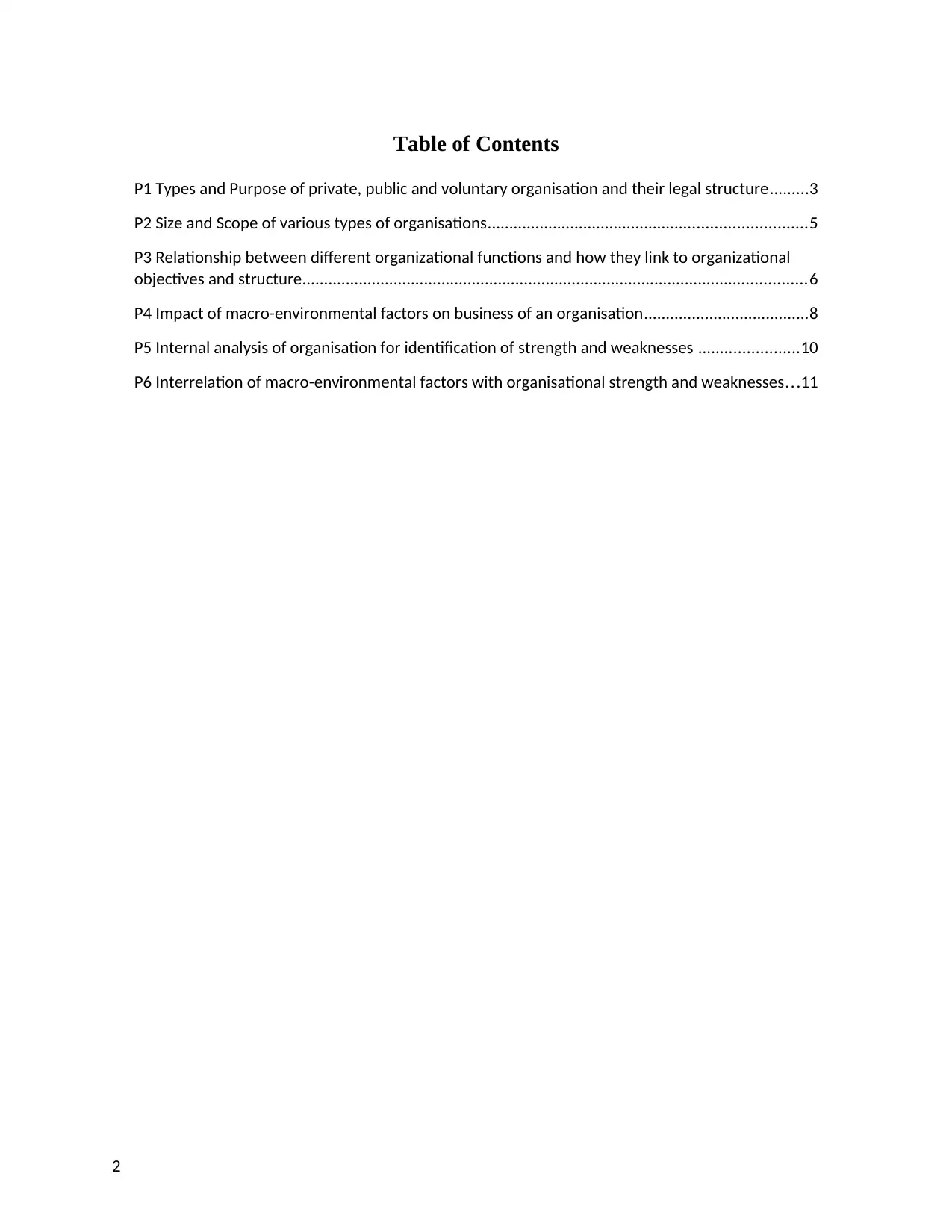
Table of Contents
P1 Types and Purpose of private, public and voluntary organisation and their legal structure.........3
P2 Size and Scope of various types of organisations.........................................................................5
P3 Relationship between different organizational functions and how they link to organizational
objectives and structure....................................................................................................................6
P4 Impact of macro-environmental factors on business of an organisation......................................8
P5 Internal analysis of organisation for identification of strength and weaknesses .......................10
P6 Interrelation of macro-environmental factors with organisational strength and weaknesses...11
2
P1 Types and Purpose of private, public and voluntary organisation and their legal structure.........3
P2 Size and Scope of various types of organisations.........................................................................5
P3 Relationship between different organizational functions and how they link to organizational
objectives and structure....................................................................................................................6
P4 Impact of macro-environmental factors on business of an organisation......................................8
P5 Internal analysis of organisation for identification of strength and weaknesses .......................10
P6 Interrelation of macro-environmental factors with organisational strength and weaknesses...11
2
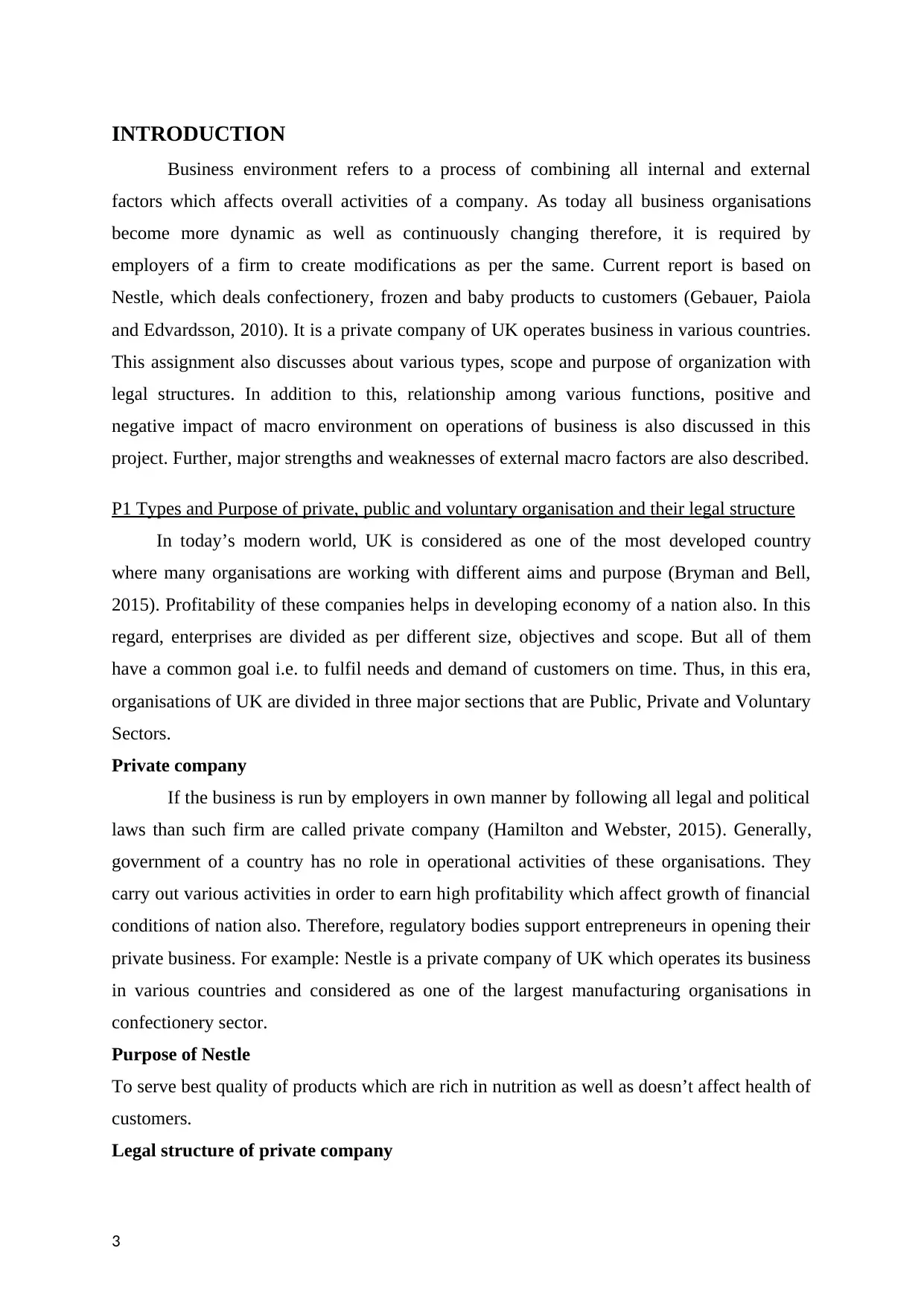
INTRODUCTION
Business environment refers to a process of combining all internal and external
factors which affects overall activities of a company. As today all business organisations
become more dynamic as well as continuously changing therefore, it is required by
employers of a firm to create modifications as per the same. Current report is based on
Nestle, which deals confectionery, frozen and baby products to customers (Gebauer, Paiola
and Edvardsson, 2010). It is a private company of UK operates business in various countries.
This assignment also discusses about various types, scope and purpose of organization with
legal structures. In addition to this, relationship among various functions, positive and
negative impact of macro environment on operations of business is also discussed in this
project. Further, major strengths and weaknesses of external macro factors are also described.
P1 Types and Purpose of private, public and voluntary organisation and their legal structure
In today’s modern world, UK is considered as one of the most developed country
where many organisations are working with different aims and purpose (Bryman and Bell,
2015). Profitability of these companies helps in developing economy of a nation also. In this
regard, enterprises are divided as per different size, objectives and scope. But all of them
have a common goal i.e. to fulfil needs and demand of customers on time. Thus, in this era,
organisations of UK are divided in three major sections that are Public, Private and Voluntary
Sectors.
Private company
If the business is run by employers in own manner by following all legal and political
laws than such firm are called private company (Hamilton and Webster, 2015). Generally,
government of a country has no role in operational activities of these organisations. They
carry out various activities in order to earn high profitability which affect growth of financial
conditions of nation also. Therefore, regulatory bodies support entrepreneurs in opening their
private business. For example: Nestle is a private company of UK which operates its business
in various countries and considered as one of the largest manufacturing organisations in
confectionery sector.
Purpose of Nestle
To serve best quality of products which are rich in nutrition as well as doesn’t affect health of
customers.
Legal structure of private company
3
Business environment refers to a process of combining all internal and external
factors which affects overall activities of a company. As today all business organisations
become more dynamic as well as continuously changing therefore, it is required by
employers of a firm to create modifications as per the same. Current report is based on
Nestle, which deals confectionery, frozen and baby products to customers (Gebauer, Paiola
and Edvardsson, 2010). It is a private company of UK operates business in various countries.
This assignment also discusses about various types, scope and purpose of organization with
legal structures. In addition to this, relationship among various functions, positive and
negative impact of macro environment on operations of business is also discussed in this
project. Further, major strengths and weaknesses of external macro factors are also described.
P1 Types and Purpose of private, public and voluntary organisation and their legal structure
In today’s modern world, UK is considered as one of the most developed country
where many organisations are working with different aims and purpose (Bryman and Bell,
2015). Profitability of these companies helps in developing economy of a nation also. In this
regard, enterprises are divided as per different size, objectives and scope. But all of them
have a common goal i.e. to fulfil needs and demand of customers on time. Thus, in this era,
organisations of UK are divided in three major sections that are Public, Private and Voluntary
Sectors.
Private company
If the business is run by employers in own manner by following all legal and political
laws than such firm are called private company (Hamilton and Webster, 2015). Generally,
government of a country has no role in operational activities of these organisations. They
carry out various activities in order to earn high profitability which affect growth of financial
conditions of nation also. Therefore, regulatory bodies support entrepreneurs in opening their
private business. For example: Nestle is a private company of UK which operates its business
in various countries and considered as one of the largest manufacturing organisations in
confectionery sector.
Purpose of Nestle
To serve best quality of products which are rich in nutrition as well as doesn’t affect health of
customers.
Legal structure of private company
3
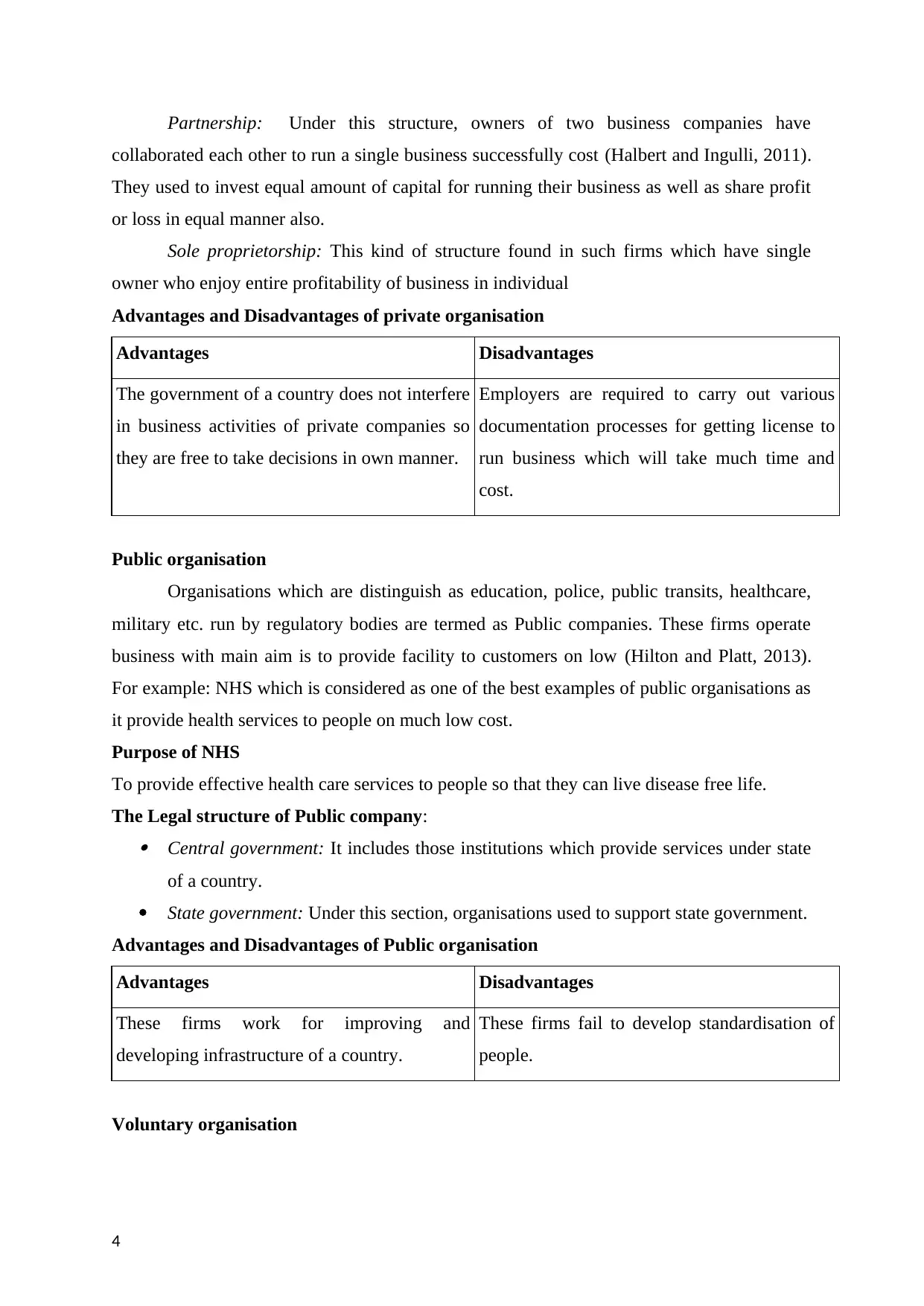
Partnership: Under this structure, owners of two business companies have
collaborated each other to run a single business successfully cost (Halbert and Ingulli, 2011).
They used to invest equal amount of capital for running their business as well as share profit
or loss in equal manner also.
Sole proprietorship: This kind of structure found in such firms which have single
owner who enjoy entire profitability of business in individual
Advantages and Disadvantages of private organisation
Advantages Disadvantages
The government of a country does not interfere
in business activities of private companies so
they are free to take decisions in own manner.
Employers are required to carry out various
documentation processes for getting license to
run business which will take much time and
cost.
Public organisation
Organisations which are distinguish as education, police, public transits, healthcare,
military etc. run by regulatory bodies are termed as Public companies. These firms operate
business with main aim is to provide facility to customers on low (Hilton and Platt, 2013).
For example: NHS which is considered as one of the best examples of public organisations as
it provide health services to people on much low cost.
Purpose of NHS
To provide effective health care services to people so that they can live disease free life.
The Legal structure of Public company: Central government: It includes those institutions which provide services under state
of a country.
State government: Under this section, organisations used to support state government.
Advantages and Disadvantages of Public organisation
Advantages Disadvantages
These firms work for improving and
developing infrastructure of a country.
These firms fail to develop standardisation of
people.
Voluntary organisation
4
collaborated each other to run a single business successfully cost (Halbert and Ingulli, 2011).
They used to invest equal amount of capital for running their business as well as share profit
or loss in equal manner also.
Sole proprietorship: This kind of structure found in such firms which have single
owner who enjoy entire profitability of business in individual
Advantages and Disadvantages of private organisation
Advantages Disadvantages
The government of a country does not interfere
in business activities of private companies so
they are free to take decisions in own manner.
Employers are required to carry out various
documentation processes for getting license to
run business which will take much time and
cost.
Public organisation
Organisations which are distinguish as education, police, public transits, healthcare,
military etc. run by regulatory bodies are termed as Public companies. These firms operate
business with main aim is to provide facility to customers on low (Hilton and Platt, 2013).
For example: NHS which is considered as one of the best examples of public organisations as
it provide health services to people on much low cost.
Purpose of NHS
To provide effective health care services to people so that they can live disease free life.
The Legal structure of Public company: Central government: It includes those institutions which provide services under state
of a country.
State government: Under this section, organisations used to support state government.
Advantages and Disadvantages of Public organisation
Advantages Disadvantages
These firms work for improving and
developing infrastructure of a country.
These firms fail to develop standardisation of
people.
Voluntary organisation
4
Secure Best Marks with AI Grader
Need help grading? Try our AI Grader for instant feedback on your assignments.
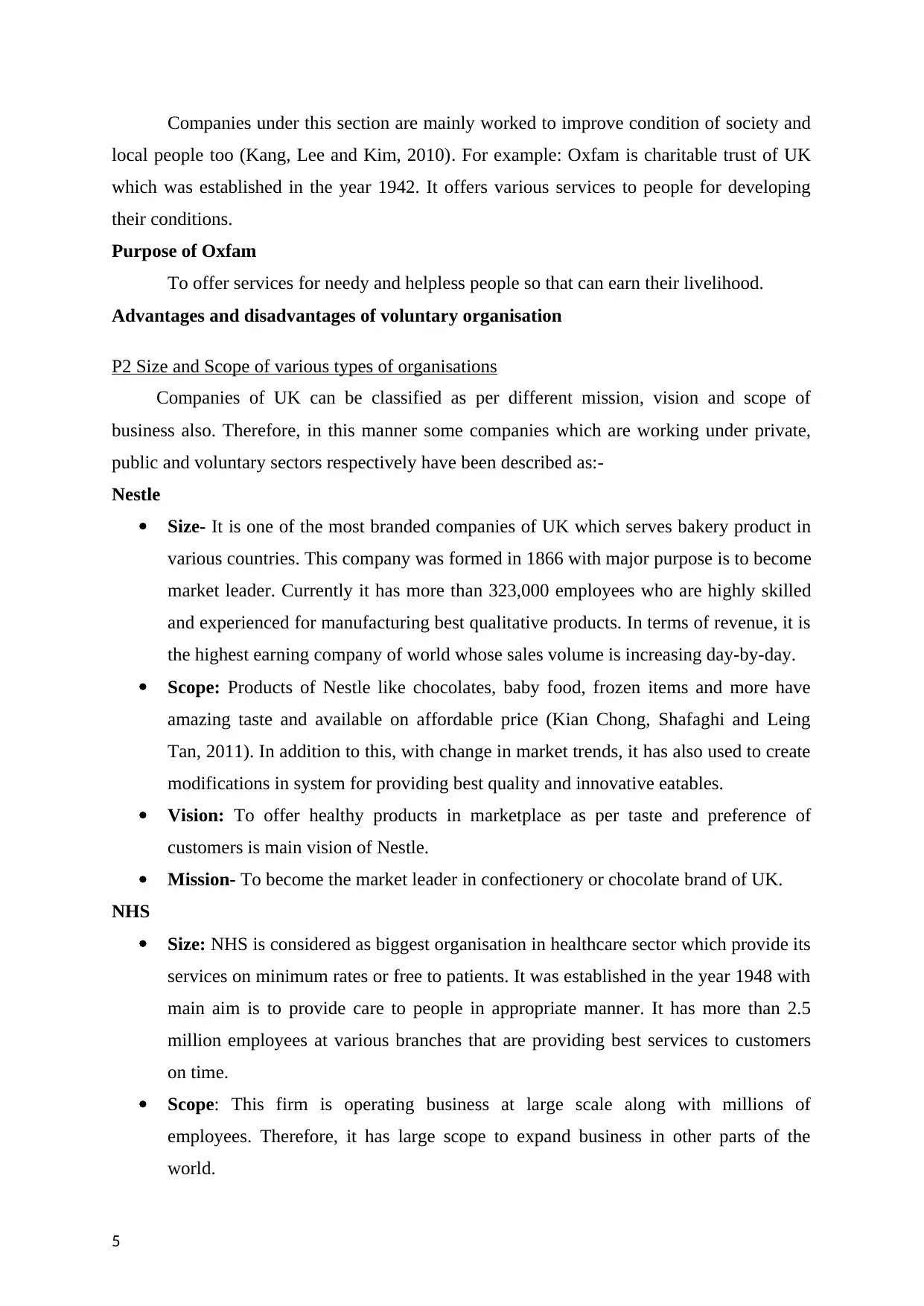
Companies under this section are mainly worked to improve condition of society and
local people too (Kang, Lee and Kim, 2010). For example: Oxfam is charitable trust of UK
which was established in the year 1942. It offers various services to people for developing
their conditions.
Purpose of Oxfam
To offer services for needy and helpless people so that can earn their livelihood.
Advantages and disadvantages of voluntary organisation
P2 Size and Scope of various types of organisations
Companies of UK can be classified as per different mission, vision and scope of
business also. Therefore, in this manner some companies which are working under private,
public and voluntary sectors respectively have been described as:-
Nestle
Size- It is one of the most branded companies of UK which serves bakery product in
various countries. This company was formed in 1866 with major purpose is to become
market leader. Currently it has more than 323,000 employees who are highly skilled
and experienced for manufacturing best qualitative products. In terms of revenue, it is
the highest earning company of world whose sales volume is increasing day-by-day.
Scope: Products of Nestle like chocolates, baby food, frozen items and more have
amazing taste and available on affordable price (Kian Chong, Shafaghi and Leing
Tan, 2011). In addition to this, with change in market trends, it has also used to create
modifications in system for providing best quality and innovative eatables.
Vision: To offer healthy products in marketplace as per taste and preference of
customers is main vision of Nestle.
Mission- To become the market leader in confectionery or chocolate brand of UK.
NHS
Size: NHS is considered as biggest organisation in healthcare sector which provide its
services on minimum rates or free to patients. It was established in the year 1948 with
main aim is to provide care to people in appropriate manner. It has more than 2.5
million employees at various branches that are providing best services to customers
on time.
Scope: This firm is operating business at large scale along with millions of
employees. Therefore, it has large scope to expand business in other parts of the
world.
5
local people too (Kang, Lee and Kim, 2010). For example: Oxfam is charitable trust of UK
which was established in the year 1942. It offers various services to people for developing
their conditions.
Purpose of Oxfam
To offer services for needy and helpless people so that can earn their livelihood.
Advantages and disadvantages of voluntary organisation
P2 Size and Scope of various types of organisations
Companies of UK can be classified as per different mission, vision and scope of
business also. Therefore, in this manner some companies which are working under private,
public and voluntary sectors respectively have been described as:-
Nestle
Size- It is one of the most branded companies of UK which serves bakery product in
various countries. This company was formed in 1866 with major purpose is to become
market leader. Currently it has more than 323,000 employees who are highly skilled
and experienced for manufacturing best qualitative products. In terms of revenue, it is
the highest earning company of world whose sales volume is increasing day-by-day.
Scope: Products of Nestle like chocolates, baby food, frozen items and more have
amazing taste and available on affordable price (Kian Chong, Shafaghi and Leing
Tan, 2011). In addition to this, with change in market trends, it has also used to create
modifications in system for providing best quality and innovative eatables.
Vision: To offer healthy products in marketplace as per taste and preference of
customers is main vision of Nestle.
Mission- To become the market leader in confectionery or chocolate brand of UK.
NHS
Size: NHS is considered as biggest organisation in healthcare sector which provide its
services on minimum rates or free to patients. It was established in the year 1948 with
main aim is to provide care to people in appropriate manner. It has more than 2.5
million employees at various branches that are providing best services to customers
on time.
Scope: This firm is operating business at large scale along with millions of
employees. Therefore, it has large scope to expand business in other parts of the
world.
5
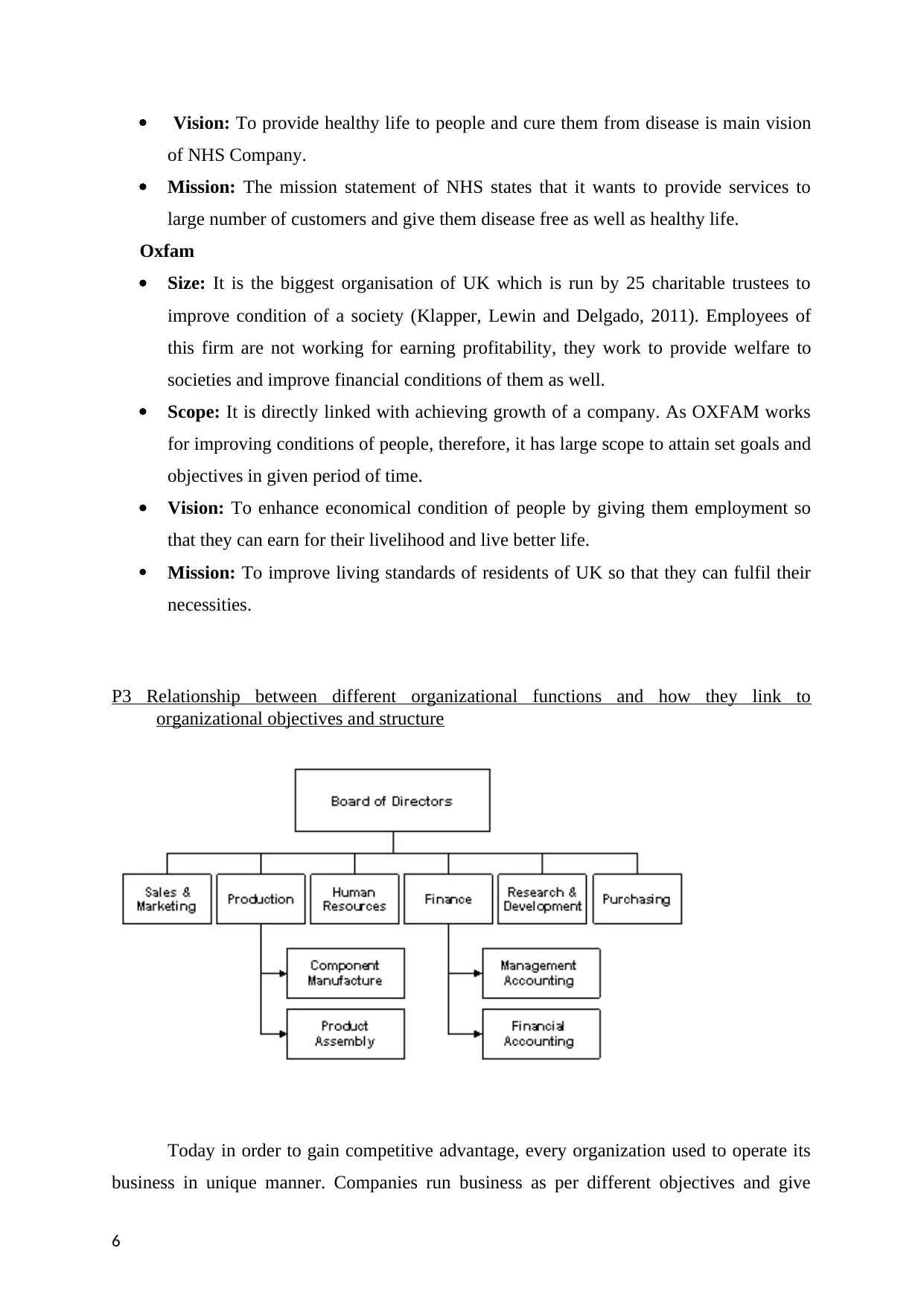
Vision: To provide healthy life to people and cure them from disease is main vision
of NHS Company.
Mission: The mission statement of NHS states that it wants to provide services to
large number of customers and give them disease free as well as healthy life.
Oxfam
Size: It is the biggest organisation of UK which is run by 25 charitable trustees to
improve condition of a society (Klapper, Lewin and Delgado, 2011). Employees of
this firm are not working for earning profitability, they work to provide welfare to
societies and improve financial conditions of them as well.
Scope: It is directly linked with achieving growth of a company. As OXFAM works
for improving conditions of people, therefore, it has large scope to attain set goals and
objectives in given period of time.
Vision: To enhance economical condition of people by giving them employment so
that they can earn for their livelihood and live better life.
Mission: To improve living standards of residents of UK so that they can fulfil their
necessities.
P3 Relationship between different organizational functions and how they link to
organizational objectives and structure
Today in order to gain competitive advantage, every organization used to operate its
business in unique manner. Companies run business as per different objectives and give
6
of NHS Company.
Mission: The mission statement of NHS states that it wants to provide services to
large number of customers and give them disease free as well as healthy life.
Oxfam
Size: It is the biggest organisation of UK which is run by 25 charitable trustees to
improve condition of a society (Klapper, Lewin and Delgado, 2011). Employees of
this firm are not working for earning profitability, they work to provide welfare to
societies and improve financial conditions of them as well.
Scope: It is directly linked with achieving growth of a company. As OXFAM works
for improving conditions of people, therefore, it has large scope to attain set goals and
objectives in given period of time.
Vision: To enhance economical condition of people by giving them employment so
that they can earn for their livelihood and live better life.
Mission: To improve living standards of residents of UK so that they can fulfil their
necessities.
P3 Relationship between different organizational functions and how they link to
organizational objectives and structure
Today in order to gain competitive advantage, every organization used to operate its
business in unique manner. Companies run business as per different objectives and give
6
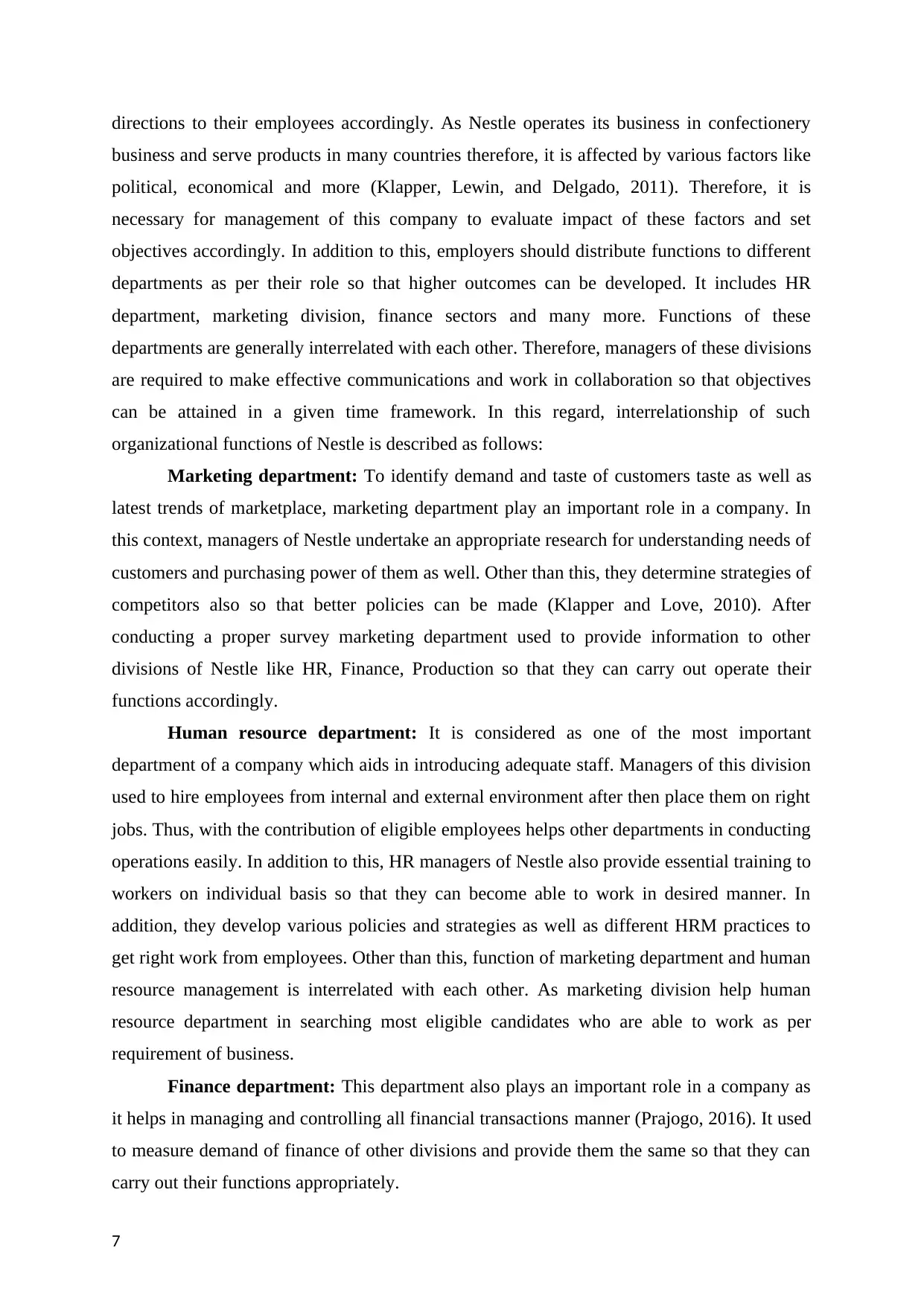
directions to their employees accordingly. As Nestle operates its business in confectionery
business and serve products in many countries therefore, it is affected by various factors like
political, economical and more (Klapper, Lewin, and Delgado, 2011). Therefore, it is
necessary for management of this company to evaluate impact of these factors and set
objectives accordingly. In addition to this, employers should distribute functions to different
departments as per their role so that higher outcomes can be developed. It includes HR
department, marketing division, finance sectors and many more. Functions of these
departments are generally interrelated with each other. Therefore, managers of these divisions
are required to make effective communications and work in collaboration so that objectives
can be attained in a given time framework. In this regard, interrelationship of such
organizational functions of Nestle is described as follows:
Marketing department: To identify demand and taste of customers taste as well as
latest trends of marketplace, marketing department play an important role in a company. In
this context, managers of Nestle undertake an appropriate research for understanding needs of
customers and purchasing power of them as well. Other than this, they determine strategies of
competitors also so that better policies can be made (Klapper and Love, 2010). After
conducting a proper survey marketing department used to provide information to other
divisions of Nestle like HR, Finance, Production so that they can carry out operate their
functions accordingly.
Human resource department: It is considered as one of the most important
department of a company which aids in introducing adequate staff. Managers of this division
used to hire employees from internal and external environment after then place them on right
jobs. Thus, with the contribution of eligible employees helps other departments in conducting
operations easily. In addition to this, HR managers of Nestle also provide essential training to
workers on individual basis so that they can become able to work in desired manner. In
addition, they develop various policies and strategies as well as different HRM practices to
get right work from employees. Other than this, function of marketing department and human
resource management is interrelated with each other. As marketing division help human
resource department in searching most eligible candidates who are able to work as per
requirement of business.
Finance department: This department also plays an important role in a company as
it helps in managing and controlling all financial transactions manner (Prajogo, 2016). It used
to measure demand of finance of other divisions and provide them the same so that they can
carry out their functions appropriately.
7
business and serve products in many countries therefore, it is affected by various factors like
political, economical and more (Klapper, Lewin, and Delgado, 2011). Therefore, it is
necessary for management of this company to evaluate impact of these factors and set
objectives accordingly. In addition to this, employers should distribute functions to different
departments as per their role so that higher outcomes can be developed. It includes HR
department, marketing division, finance sectors and many more. Functions of these
departments are generally interrelated with each other. Therefore, managers of these divisions
are required to make effective communications and work in collaboration so that objectives
can be attained in a given time framework. In this regard, interrelationship of such
organizational functions of Nestle is described as follows:
Marketing department: To identify demand and taste of customers taste as well as
latest trends of marketplace, marketing department play an important role in a company. In
this context, managers of Nestle undertake an appropriate research for understanding needs of
customers and purchasing power of them as well. Other than this, they determine strategies of
competitors also so that better policies can be made (Klapper and Love, 2010). After
conducting a proper survey marketing department used to provide information to other
divisions of Nestle like HR, Finance, Production so that they can carry out operate their
functions accordingly.
Human resource department: It is considered as one of the most important
department of a company which aids in introducing adequate staff. Managers of this division
used to hire employees from internal and external environment after then place them on right
jobs. Thus, with the contribution of eligible employees helps other departments in conducting
operations easily. In addition to this, HR managers of Nestle also provide essential training to
workers on individual basis so that they can become able to work in desired manner. In
addition, they develop various policies and strategies as well as different HRM practices to
get right work from employees. Other than this, function of marketing department and human
resource management is interrelated with each other. As marketing division help human
resource department in searching most eligible candidates who are able to work as per
requirement of business.
Finance department: This department also plays an important role in a company as
it helps in managing and controlling all financial transactions manner (Prajogo, 2016). It used
to measure demand of finance of other divisions and provide them the same so that they can
carry out their functions appropriately.
7
Paraphrase This Document
Need a fresh take? Get an instant paraphrase of this document with our AI Paraphraser
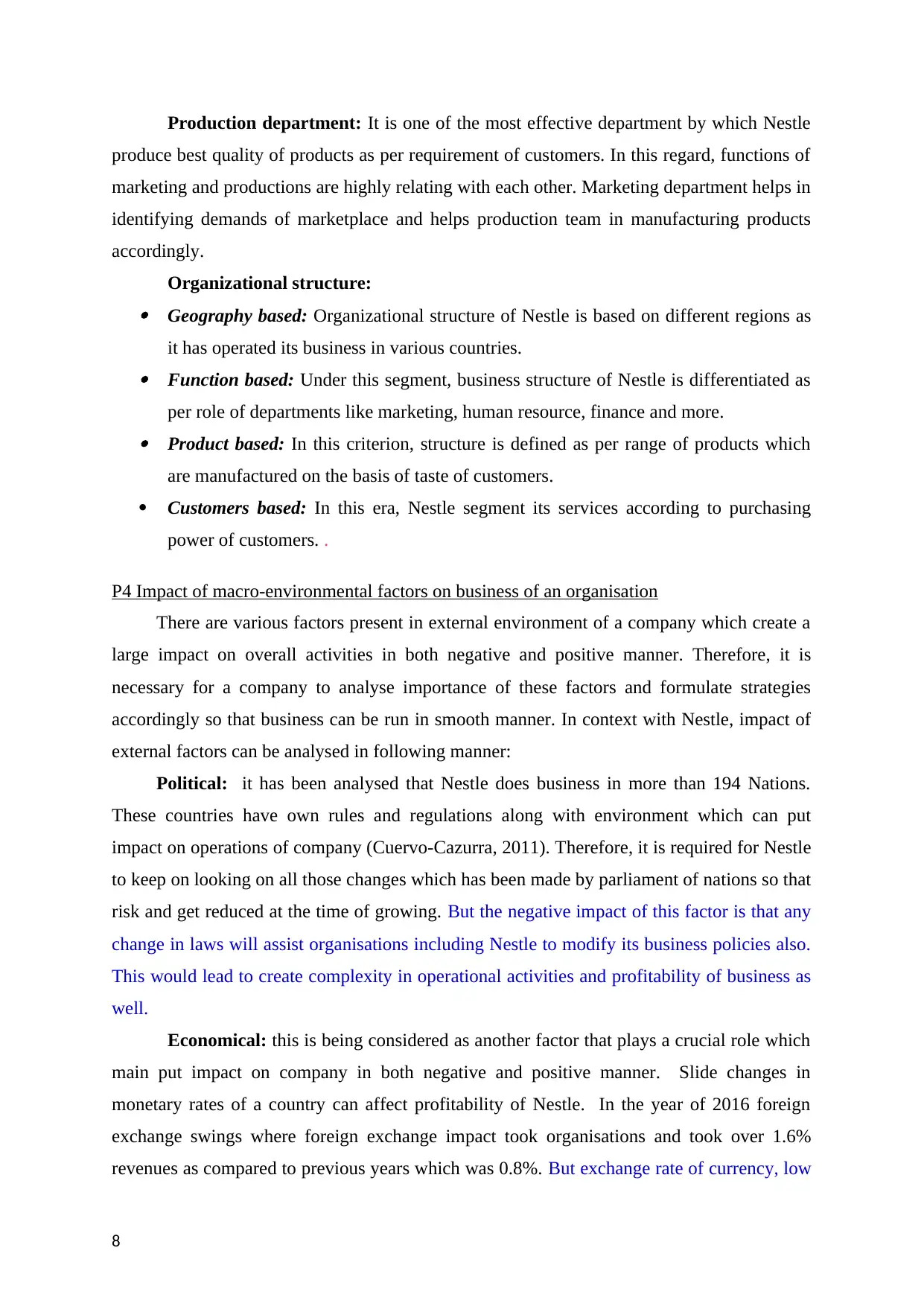
Production department: It is one of the most effective department by which Nestle
produce best quality of products as per requirement of customers. In this regard, functions of
marketing and productions are highly relating with each other. Marketing department helps in
identifying demands of marketplace and helps production team in manufacturing products
accordingly.
Organizational structure: Geography based: Organizational structure of Nestle is based on different regions as
it has operated its business in various countries. Function based: Under this segment, business structure of Nestle is differentiated as
per role of departments like marketing, human resource, finance and more. Product based: In this criterion, structure is defined as per range of products which
are manufactured on the basis of taste of customers.
Customers based: In this era, Nestle segment its services according to purchasing
power of customers. .
P4 Impact of macro-environmental factors on business of an organisation
There are various factors present in external environment of a company which create a
large impact on overall activities in both negative and positive manner. Therefore, it is
necessary for a company to analyse importance of these factors and formulate strategies
accordingly so that business can be run in smooth manner. In context with Nestle, impact of
external factors can be analysed in following manner:
Political: it has been analysed that Nestle does business in more than 194 Nations.
These countries have own rules and regulations along with environment which can put
impact on operations of company (Cuervo‐Cazurra, 2011). Therefore, it is required for Nestle
to keep on looking on all those changes which has been made by parliament of nations so that
risk and get reduced at the time of growing. But the negative impact of this factor is that any
change in laws will assist organisations including Nestle to modify its business policies also.
This would lead to create complexity in operational activities and profitability of business as
well.
Economical: this is being considered as another factor that plays a crucial role which
main put impact on company in both negative and positive manner. Slide changes in
monetary rates of a country can affect profitability of Nestle. In the year of 2016 foreign
exchange swings where foreign exchange impact took organisations and took over 1.6%
revenues as compared to previous years which was 0.8%. But exchange rate of currency, low
8
produce best quality of products as per requirement of customers. In this regard, functions of
marketing and productions are highly relating with each other. Marketing department helps in
identifying demands of marketplace and helps production team in manufacturing products
accordingly.
Organizational structure: Geography based: Organizational structure of Nestle is based on different regions as
it has operated its business in various countries. Function based: Under this segment, business structure of Nestle is differentiated as
per role of departments like marketing, human resource, finance and more. Product based: In this criterion, structure is defined as per range of products which
are manufactured on the basis of taste of customers.
Customers based: In this era, Nestle segment its services according to purchasing
power of customers. .
P4 Impact of macro-environmental factors on business of an organisation
There are various factors present in external environment of a company which create a
large impact on overall activities in both negative and positive manner. Therefore, it is
necessary for a company to analyse importance of these factors and formulate strategies
accordingly so that business can be run in smooth manner. In context with Nestle, impact of
external factors can be analysed in following manner:
Political: it has been analysed that Nestle does business in more than 194 Nations.
These countries have own rules and regulations along with environment which can put
impact on operations of company (Cuervo‐Cazurra, 2011). Therefore, it is required for Nestle
to keep on looking on all those changes which has been made by parliament of nations so that
risk and get reduced at the time of growing. But the negative impact of this factor is that any
change in laws will assist organisations including Nestle to modify its business policies also.
This would lead to create complexity in operational activities and profitability of business as
well.
Economical: this is being considered as another factor that plays a crucial role which
main put impact on company in both negative and positive manner. Slide changes in
monetary rates of a country can affect profitability of Nestle. In the year of 2016 foreign
exchange swings where foreign exchange impact took organisations and took over 1.6%
revenues as compared to previous years which was 0.8%. But exchange rate of currency, low
8
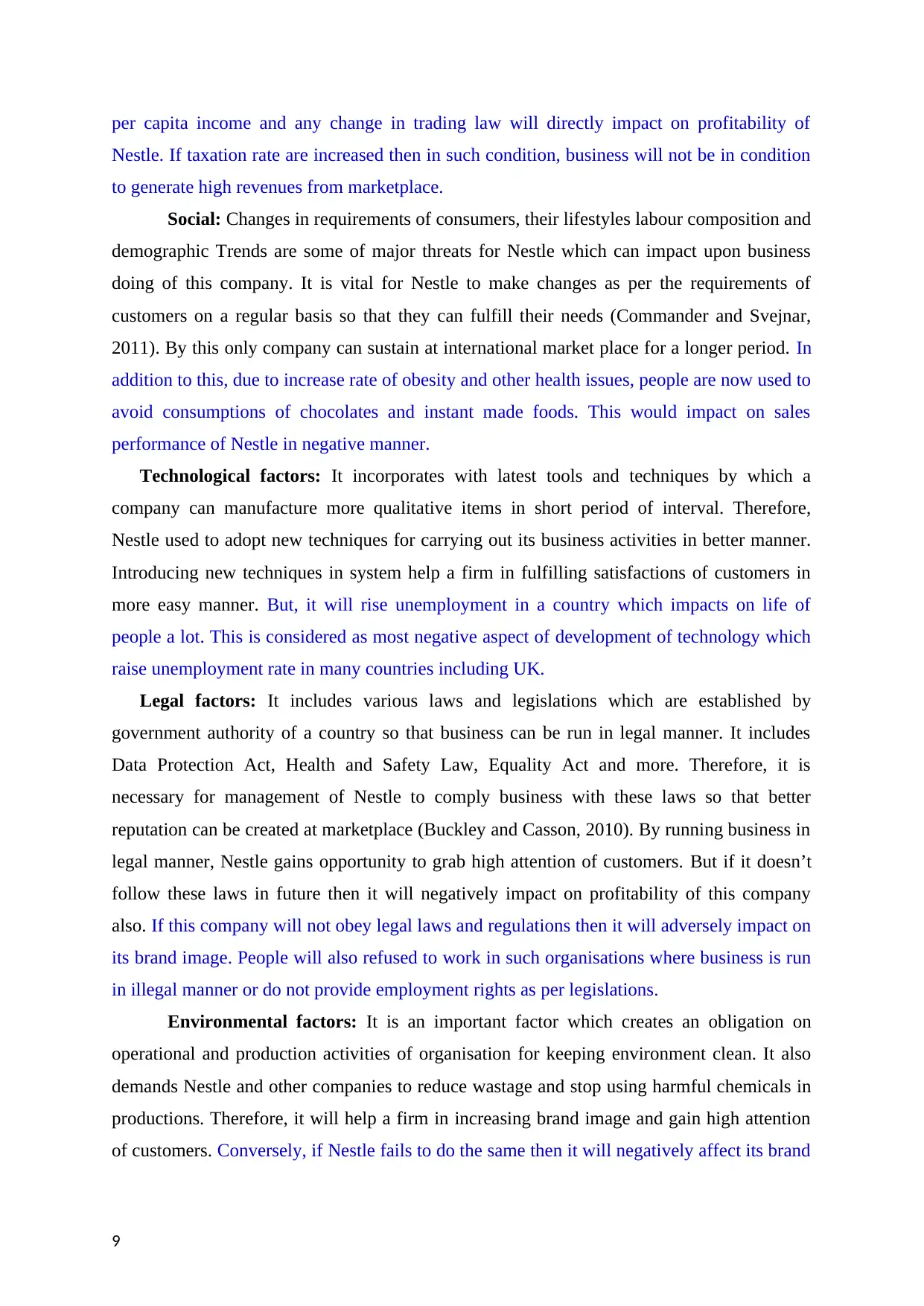
per capita income and any change in trading law will directly impact on profitability of
Nestle. If taxation rate are increased then in such condition, business will not be in condition
to generate high revenues from marketplace.
Social: Changes in requirements of consumers, their lifestyles labour composition and
demographic Trends are some of major threats for Nestle which can impact upon business
doing of this company. It is vital for Nestle to make changes as per the requirements of
customers on a regular basis so that they can fulfill their needs (Commander and Svejnar,
2011). By this only company can sustain at international market place for a longer period. In
addition to this, due to increase rate of obesity and other health issues, people are now used to
avoid consumptions of chocolates and instant made foods. This would impact on sales
performance of Nestle in negative manner.
Technological factors: It incorporates with latest tools and techniques by which a
company can manufacture more qualitative items in short period of interval. Therefore,
Nestle used to adopt new techniques for carrying out its business activities in better manner.
Introducing new techniques in system help a firm in fulfilling satisfactions of customers in
more easy manner. But, it will rise unemployment in a country which impacts on life of
people a lot. This is considered as most negative aspect of development of technology which
raise unemployment rate in many countries including UK.
Legal factors: It includes various laws and legislations which are established by
government authority of a country so that business can be run in legal manner. It includes
Data Protection Act, Health and Safety Law, Equality Act and more. Therefore, it is
necessary for management of Nestle to comply business with these laws so that better
reputation can be created at marketplace (Buckley and Casson, 2010). By running business in
legal manner, Nestle gains opportunity to grab high attention of customers. But if it doesn’t
follow these laws in future then it will negatively impact on profitability of this company
also. If this company will not obey legal laws and regulations then it will adversely impact on
its brand image. People will also refused to work in such organisations where business is run
in illegal manner or do not provide employment rights as per legislations.
Environmental factors: It is an important factor which creates an obligation on
operational and production activities of organisation for keeping environment clean. It also
demands Nestle and other companies to reduce wastage and stop using harmful chemicals in
productions. Therefore, it will help a firm in increasing brand image and gain high attention
of customers. Conversely, if Nestle fails to do the same then it will negatively affect its brand
9
Nestle. If taxation rate are increased then in such condition, business will not be in condition
to generate high revenues from marketplace.
Social: Changes in requirements of consumers, their lifestyles labour composition and
demographic Trends are some of major threats for Nestle which can impact upon business
doing of this company. It is vital for Nestle to make changes as per the requirements of
customers on a regular basis so that they can fulfill their needs (Commander and Svejnar,
2011). By this only company can sustain at international market place for a longer period. In
addition to this, due to increase rate of obesity and other health issues, people are now used to
avoid consumptions of chocolates and instant made foods. This would impact on sales
performance of Nestle in negative manner.
Technological factors: It incorporates with latest tools and techniques by which a
company can manufacture more qualitative items in short period of interval. Therefore,
Nestle used to adopt new techniques for carrying out its business activities in better manner.
Introducing new techniques in system help a firm in fulfilling satisfactions of customers in
more easy manner. But, it will rise unemployment in a country which impacts on life of
people a lot. This is considered as most negative aspect of development of technology which
raise unemployment rate in many countries including UK.
Legal factors: It includes various laws and legislations which are established by
government authority of a country so that business can be run in legal manner. It includes
Data Protection Act, Health and Safety Law, Equality Act and more. Therefore, it is
necessary for management of Nestle to comply business with these laws so that better
reputation can be created at marketplace (Buckley and Casson, 2010). By running business in
legal manner, Nestle gains opportunity to grab high attention of customers. But if it doesn’t
follow these laws in future then it will negatively impact on profitability of this company
also. If this company will not obey legal laws and regulations then it will adversely impact on
its brand image. People will also refused to work in such organisations where business is run
in illegal manner or do not provide employment rights as per legislations.
Environmental factors: It is an important factor which creates an obligation on
operational and production activities of organisation for keeping environment clean. It also
demands Nestle and other companies to reduce wastage and stop using harmful chemicals in
productions. Therefore, it will help a firm in increasing brand image and gain high attention
of customers. Conversely, if Nestle fails to do the same then it will negatively affect its brand
9
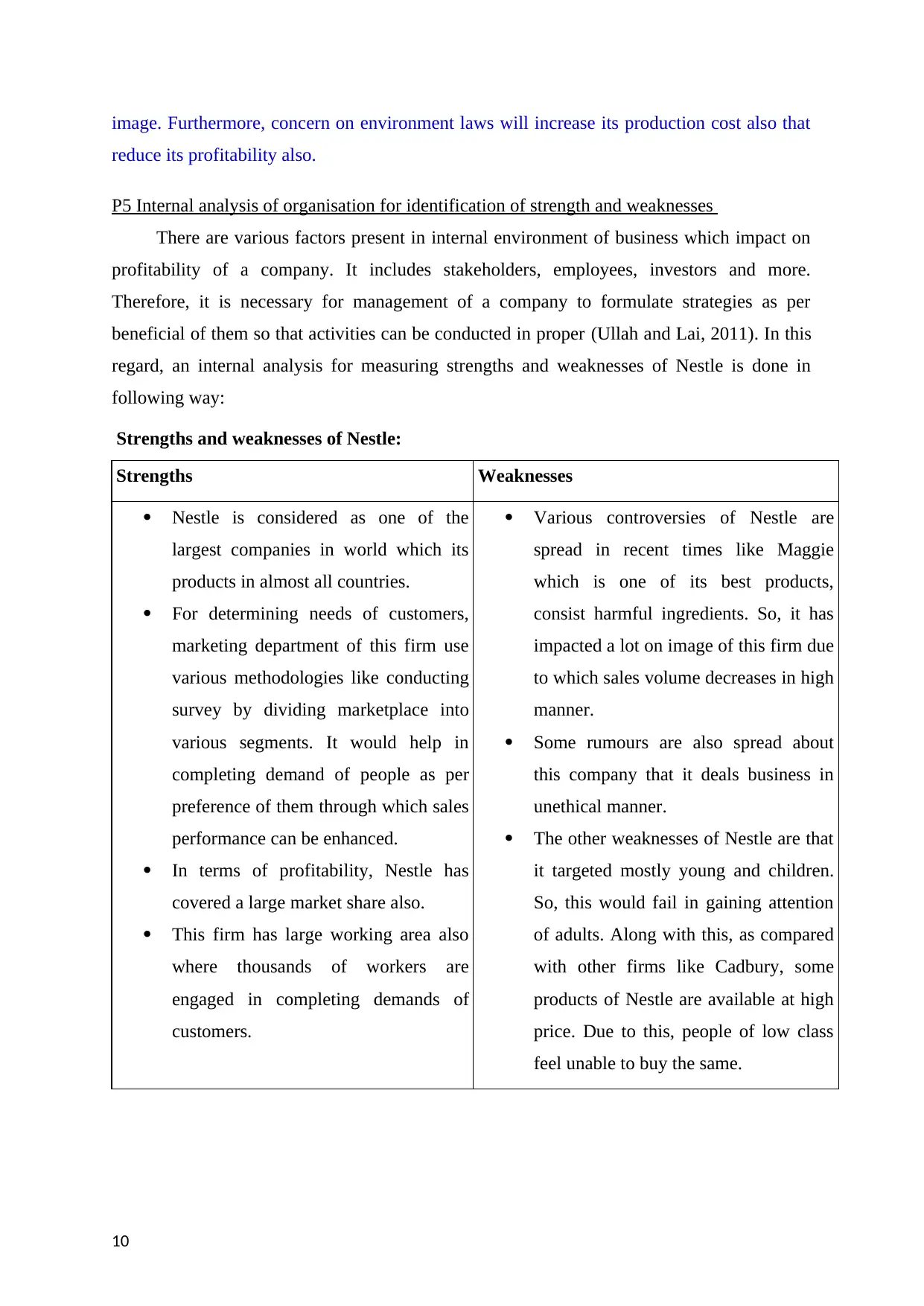
image. Furthermore, concern on environment laws will increase its production cost also that
reduce its profitability also.
P5 Internal analysis of organisation for identification of strength and weaknesses
There are various factors present in internal environment of business which impact on
profitability of a company. It includes stakeholders, employees, investors and more.
Therefore, it is necessary for management of a company to formulate strategies as per
beneficial of them so that activities can be conducted in proper (Ullah and Lai, 2011). In this
regard, an internal analysis for measuring strengths and weaknesses of Nestle is done in
following way:
Strengths and weaknesses of Nestle:
Strengths Weaknesses
Nestle is considered as one of the
largest companies in world which its
products in almost all countries.
For determining needs of customers,
marketing department of this firm use
various methodologies like conducting
survey by dividing marketplace into
various segments. It would help in
completing demand of people as per
preference of them through which sales
performance can be enhanced.
In terms of profitability, Nestle has
covered a large market share also.
This firm has large working area also
where thousands of workers are
engaged in completing demands of
customers.
Various controversies of Nestle are
spread in recent times like Maggie
which is one of its best products,
consist harmful ingredients. So, it has
impacted a lot on image of this firm due
to which sales volume decreases in high
manner.
Some rumours are also spread about
this company that it deals business in
unethical manner.
The other weaknesses of Nestle are that
it targeted mostly young and children.
So, this would fail in gaining attention
of adults. Along with this, as compared
with other firms like Cadbury, some
products of Nestle are available at high
price. Due to this, people of low class
feel unable to buy the same.
10
reduce its profitability also.
P5 Internal analysis of organisation for identification of strength and weaknesses
There are various factors present in internal environment of business which impact on
profitability of a company. It includes stakeholders, employees, investors and more.
Therefore, it is necessary for management of a company to formulate strategies as per
beneficial of them so that activities can be conducted in proper (Ullah and Lai, 2011). In this
regard, an internal analysis for measuring strengths and weaknesses of Nestle is done in
following way:
Strengths and weaknesses of Nestle:
Strengths Weaknesses
Nestle is considered as one of the
largest companies in world which its
products in almost all countries.
For determining needs of customers,
marketing department of this firm use
various methodologies like conducting
survey by dividing marketplace into
various segments. It would help in
completing demand of people as per
preference of them through which sales
performance can be enhanced.
In terms of profitability, Nestle has
covered a large market share also.
This firm has large working area also
where thousands of workers are
engaged in completing demands of
customers.
Various controversies of Nestle are
spread in recent times like Maggie
which is one of its best products,
consist harmful ingredients. So, it has
impacted a lot on image of this firm due
to which sales volume decreases in high
manner.
Some rumours are also spread about
this company that it deals business in
unethical manner.
The other weaknesses of Nestle are that
it targeted mostly young and children.
So, this would fail in gaining attention
of adults. Along with this, as compared
with other firms like Cadbury, some
products of Nestle are available at high
price. Due to this, people of low class
feel unable to buy the same.
10
Secure Best Marks with AI Grader
Need help grading? Try our AI Grader for instant feedback on your assignments.
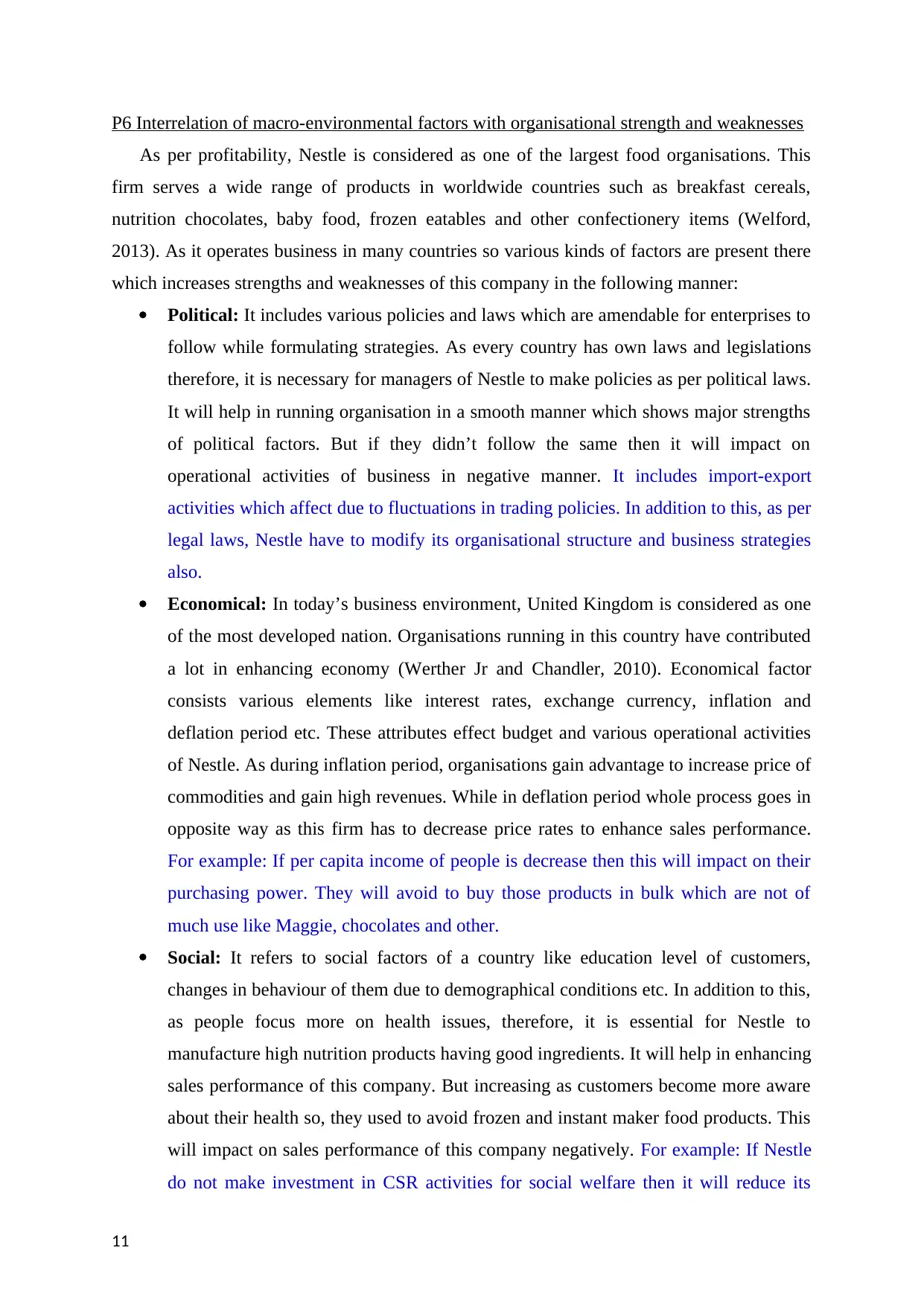
P6 Interrelation of macro-environmental factors with organisational strength and weaknesses
As per profitability, Nestle is considered as one of the largest food organisations. This
firm serves a wide range of products in worldwide countries such as breakfast cereals,
nutrition chocolates, baby food, frozen eatables and other confectionery items (Welford,
2013). As it operates business in many countries so various kinds of factors are present there
which increases strengths and weaknesses of this company in the following manner:
Political: It includes various policies and laws which are amendable for enterprises to
follow while formulating strategies. As every country has own laws and legislations
therefore, it is necessary for managers of Nestle to make policies as per political laws.
It will help in running organisation in a smooth manner which shows major strengths
of political factors. But if they didn’t follow the same then it will impact on
operational activities of business in negative manner. It includes import-export
activities which affect due to fluctuations in trading policies. In addition to this, as per
legal laws, Nestle have to modify its organisational structure and business strategies
also.
Economical: In today’s business environment, United Kingdom is considered as one
of the most developed nation. Organisations running in this country have contributed
a lot in enhancing economy (Werther Jr and Chandler, 2010). Economical factor
consists various elements like interest rates, exchange currency, inflation and
deflation period etc. These attributes effect budget and various operational activities
of Nestle. As during inflation period, organisations gain advantage to increase price of
commodities and gain high revenues. While in deflation period whole process goes in
opposite way as this firm has to decrease price rates to enhance sales performance.
For example: If per capita income of people is decrease then this will impact on their
purchasing power. They will avoid to buy those products in bulk which are not of
much use like Maggie, chocolates and other.
Social: It refers to social factors of a country like education level of customers,
changes in behaviour of them due to demographical conditions etc. In addition to this,
as people focus more on health issues, therefore, it is essential for Nestle to
manufacture high nutrition products having good ingredients. It will help in enhancing
sales performance of this company. But increasing as customers become more aware
about their health so, they used to avoid frozen and instant maker food products. This
will impact on sales performance of this company negatively. For example: If Nestle
do not make investment in CSR activities for social welfare then it will reduce its
11
As per profitability, Nestle is considered as one of the largest food organisations. This
firm serves a wide range of products in worldwide countries such as breakfast cereals,
nutrition chocolates, baby food, frozen eatables and other confectionery items (Welford,
2013). As it operates business in many countries so various kinds of factors are present there
which increases strengths and weaknesses of this company in the following manner:
Political: It includes various policies and laws which are amendable for enterprises to
follow while formulating strategies. As every country has own laws and legislations
therefore, it is necessary for managers of Nestle to make policies as per political laws.
It will help in running organisation in a smooth manner which shows major strengths
of political factors. But if they didn’t follow the same then it will impact on
operational activities of business in negative manner. It includes import-export
activities which affect due to fluctuations in trading policies. In addition to this, as per
legal laws, Nestle have to modify its organisational structure and business strategies
also.
Economical: In today’s business environment, United Kingdom is considered as one
of the most developed nation. Organisations running in this country have contributed
a lot in enhancing economy (Werther Jr and Chandler, 2010). Economical factor
consists various elements like interest rates, exchange currency, inflation and
deflation period etc. These attributes effect budget and various operational activities
of Nestle. As during inflation period, organisations gain advantage to increase price of
commodities and gain high revenues. While in deflation period whole process goes in
opposite way as this firm has to decrease price rates to enhance sales performance.
For example: If per capita income of people is decrease then this will impact on their
purchasing power. They will avoid to buy those products in bulk which are not of
much use like Maggie, chocolates and other.
Social: It refers to social factors of a country like education level of customers,
changes in behaviour of them due to demographical conditions etc. In addition to this,
as people focus more on health issues, therefore, it is essential for Nestle to
manufacture high nutrition products having good ingredients. It will help in enhancing
sales performance of this company. But increasing as customers become more aware
about their health so, they used to avoid frozen and instant maker food products. This
will impact on sales performance of this company negatively. For example: If Nestle
do not make investment in CSR activities for social welfare then it will reduce its
11
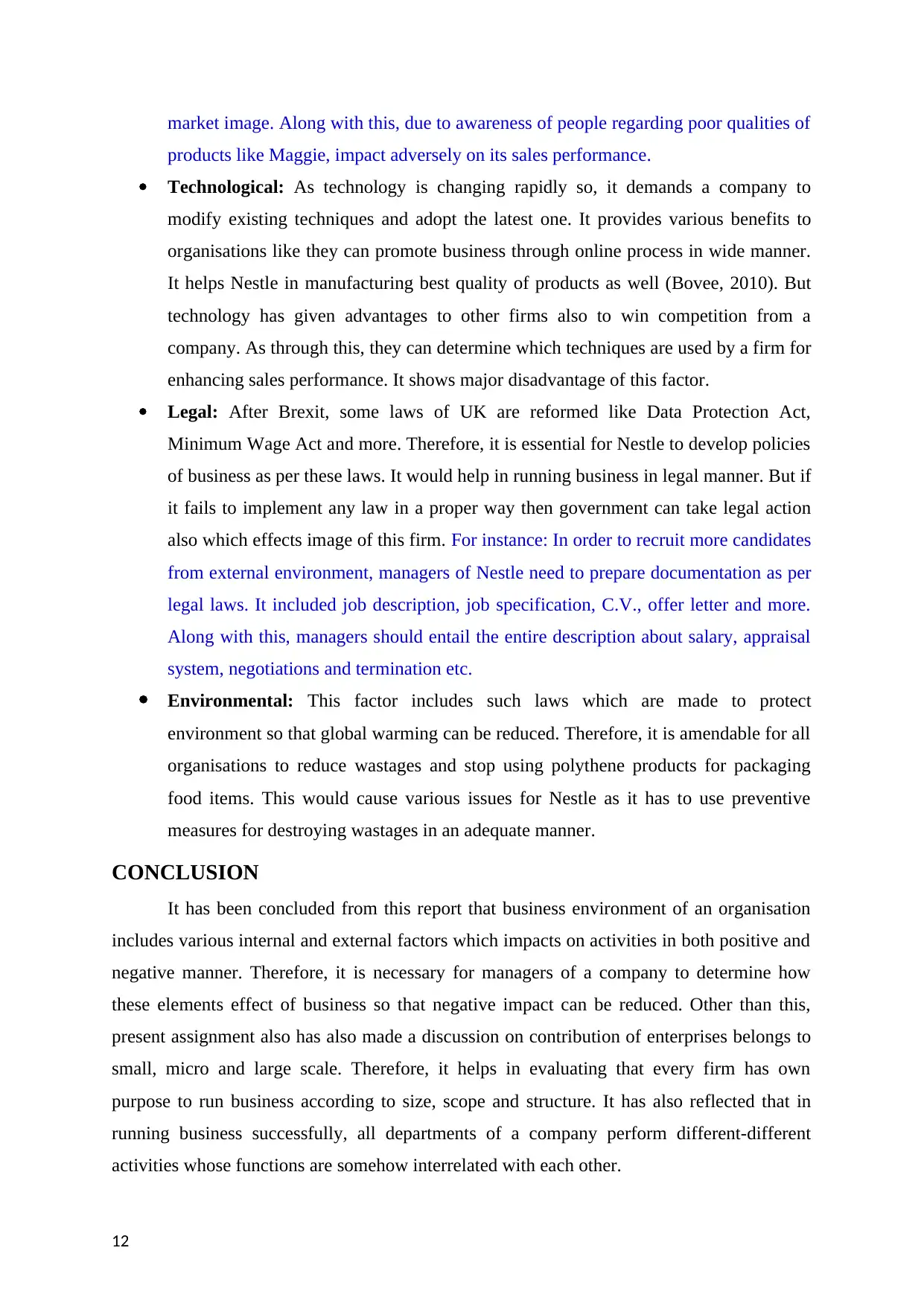
market image. Along with this, due to awareness of people regarding poor qualities of
products like Maggie, impact adversely on its sales performance.
Technological: As technology is changing rapidly so, it demands a company to
modify existing techniques and adopt the latest one. It provides various benefits to
organisations like they can promote business through online process in wide manner.
It helps Nestle in manufacturing best quality of products as well (Bovee, 2010). But
technology has given advantages to other firms also to win competition from a
company. As through this, they can determine which techniques are used by a firm for
enhancing sales performance. It shows major disadvantage of this factor.
Legal: After Brexit, some laws of UK are reformed like Data Protection Act,
Minimum Wage Act and more. Therefore, it is essential for Nestle to develop policies
of business as per these laws. It would help in running business in legal manner. But if
it fails to implement any law in a proper way then government can take legal action
also which effects image of this firm. For instance: In order to recruit more candidates
from external environment, managers of Nestle need to prepare documentation as per
legal laws. It included job description, job specification, C.V., offer letter and more.
Along with this, managers should entail the entire description about salary, appraisal
system, negotiations and termination etc.
Environmental: This factor includes such laws which are made to protect
environment so that global warming can be reduced. Therefore, it is amendable for all
organisations to reduce wastages and stop using polythene products for packaging
food items. This would cause various issues for Nestle as it has to use preventive
measures for destroying wastages in an adequate manner.
CONCLUSION
It has been concluded from this report that business environment of an organisation
includes various internal and external factors which impacts on activities in both positive and
negative manner. Therefore, it is necessary for managers of a company to determine how
these elements effect of business so that negative impact can be reduced. Other than this,
present assignment also has also made a discussion on contribution of enterprises belongs to
small, micro and large scale. Therefore, it helps in evaluating that every firm has own
purpose to run business according to size, scope and structure. It has also reflected that in
running business successfully, all departments of a company perform different-different
activities whose functions are somehow interrelated with each other.
12
products like Maggie, impact adversely on its sales performance.
Technological: As technology is changing rapidly so, it demands a company to
modify existing techniques and adopt the latest one. It provides various benefits to
organisations like they can promote business through online process in wide manner.
It helps Nestle in manufacturing best quality of products as well (Bovee, 2010). But
technology has given advantages to other firms also to win competition from a
company. As through this, they can determine which techniques are used by a firm for
enhancing sales performance. It shows major disadvantage of this factor.
Legal: After Brexit, some laws of UK are reformed like Data Protection Act,
Minimum Wage Act and more. Therefore, it is essential for Nestle to develop policies
of business as per these laws. It would help in running business in legal manner. But if
it fails to implement any law in a proper way then government can take legal action
also which effects image of this firm. For instance: In order to recruit more candidates
from external environment, managers of Nestle need to prepare documentation as per
legal laws. It included job description, job specification, C.V., offer letter and more.
Along with this, managers should entail the entire description about salary, appraisal
system, negotiations and termination etc.
Environmental: This factor includes such laws which are made to protect
environment so that global warming can be reduced. Therefore, it is amendable for all
organisations to reduce wastages and stop using polythene products for packaging
food items. This would cause various issues for Nestle as it has to use preventive
measures for destroying wastages in an adequate manner.
CONCLUSION
It has been concluded from this report that business environment of an organisation
includes various internal and external factors which impacts on activities in both positive and
negative manner. Therefore, it is necessary for managers of a company to determine how
these elements effect of business so that negative impact can be reduced. Other than this,
present assignment also has also made a discussion on contribution of enterprises belongs to
small, micro and large scale. Therefore, it helps in evaluating that every firm has own
purpose to run business according to size, scope and structure. It has also reflected that in
running business successfully, all departments of a company perform different-different
activities whose functions are somehow interrelated with each other.
12
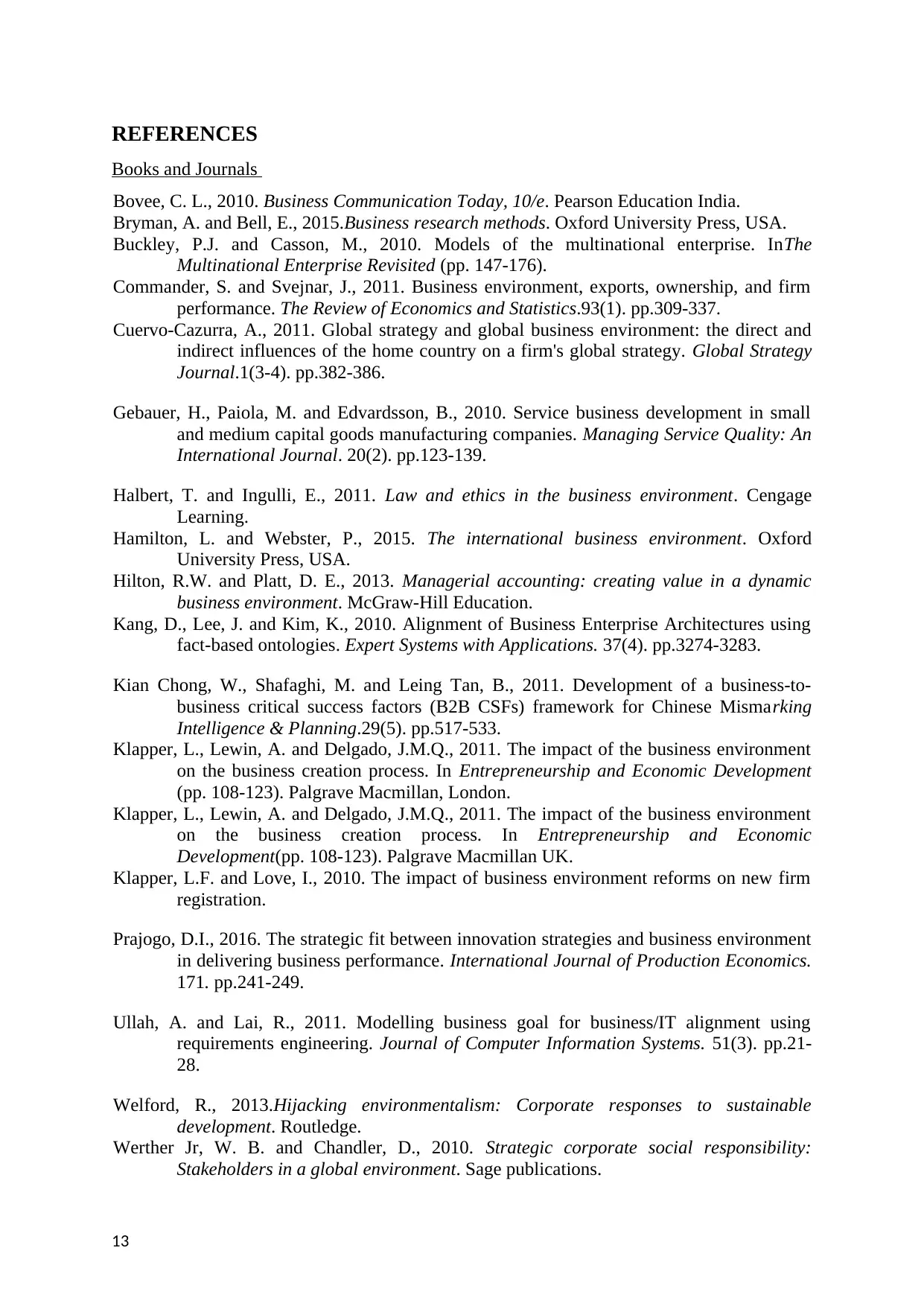
REFERENCES
Books and Journals
Bovee, C. L., 2010. Business Communication Today, 10/e. Pearson Education India.
Bryman, A. and Bell, E., 2015.Business research methods. Oxford University Press, USA.
Buckley, P.J. and Casson, M., 2010. Models of the multinational enterprise. InThe
Multinational Enterprise Revisited (pp. 147-176).
Commander, S. and Svejnar, J., 2011. Business environment, exports, ownership, and firm
performance. The Review of Economics and Statistics.93(1). pp.309-337.
Cuervo‐Cazurra, A., 2011. Global strategy and global business environment: the direct and
indirect influences of the home country on a firm's global strategy. Global Strategy
Journal.1(3‐4). pp.382-386.
Gebauer, H., Paiola, M. and Edvardsson, B., 2010. Service business development in small
and medium capital goods manufacturing companies. Managing Service Quality: An
International Journal. 20(2). pp.123-139.
Halbert, T. and Ingulli, E., 2011. Law and ethics in the business environment. Cengage
Learning.
Hamilton, L. and Webster, P., 2015. The international business environment. Oxford
University Press, USA.
Hilton, R.W. and Platt, D. E., 2013. Managerial accounting: creating value in a dynamic
business environment. McGraw-Hill Education.
Kang, D., Lee, J. and Kim, K., 2010. Alignment of Business Enterprise Architectures using
fact-based ontologies. Expert Systems with Applications. 37(4). pp.3274-3283.
Kian Chong, W., Shafaghi, M. and Leing Tan, B., 2011. Development of a business-to-
business critical success factors (B2B CSFs) framework for Chinese Mismarking
Intelligence & Planning.29(5). pp.517-533.
Klapper, L., Lewin, A. and Delgado, J.M.Q., 2011. The impact of the business environment
on the business creation process. In Entrepreneurship and Economic Development
(pp. 108-123). Palgrave Macmillan, London.
Klapper, L., Lewin, A. and Delgado, J.M.Q., 2011. The impact of the business environment
on the business creation process. In Entrepreneurship and Economic
Development(pp. 108-123). Palgrave Macmillan UK.
Klapper, L.F. and Love, I., 2010. The impact of business environment reforms on new firm
registration.
Prajogo, D.I., 2016. The strategic fit between innovation strategies and business environment
in delivering business performance. International Journal of Production Economics.
171. pp.241-249.
Ullah, A. and Lai, R., 2011. Modelling business goal for business/IT alignment using
requirements engineering. Journal of Computer Information Systems. 51(3). pp.21-
28.
Welford, R., 2013.Hijacking environmentalism: Corporate responses to sustainable
development. Routledge.
Werther Jr, W. B. and Chandler, D., 2010. Strategic corporate social responsibility:
Stakeholders in a global environment. Sage publications.
13
Books and Journals
Bovee, C. L., 2010. Business Communication Today, 10/e. Pearson Education India.
Bryman, A. and Bell, E., 2015.Business research methods. Oxford University Press, USA.
Buckley, P.J. and Casson, M., 2010. Models of the multinational enterprise. InThe
Multinational Enterprise Revisited (pp. 147-176).
Commander, S. and Svejnar, J., 2011. Business environment, exports, ownership, and firm
performance. The Review of Economics and Statistics.93(1). pp.309-337.
Cuervo‐Cazurra, A., 2011. Global strategy and global business environment: the direct and
indirect influences of the home country on a firm's global strategy. Global Strategy
Journal.1(3‐4). pp.382-386.
Gebauer, H., Paiola, M. and Edvardsson, B., 2010. Service business development in small
and medium capital goods manufacturing companies. Managing Service Quality: An
International Journal. 20(2). pp.123-139.
Halbert, T. and Ingulli, E., 2011. Law and ethics in the business environment. Cengage
Learning.
Hamilton, L. and Webster, P., 2015. The international business environment. Oxford
University Press, USA.
Hilton, R.W. and Platt, D. E., 2013. Managerial accounting: creating value in a dynamic
business environment. McGraw-Hill Education.
Kang, D., Lee, J. and Kim, K., 2010. Alignment of Business Enterprise Architectures using
fact-based ontologies. Expert Systems with Applications. 37(4). pp.3274-3283.
Kian Chong, W., Shafaghi, M. and Leing Tan, B., 2011. Development of a business-to-
business critical success factors (B2B CSFs) framework for Chinese Mismarking
Intelligence & Planning.29(5). pp.517-533.
Klapper, L., Lewin, A. and Delgado, J.M.Q., 2011. The impact of the business environment
on the business creation process. In Entrepreneurship and Economic Development
(pp. 108-123). Palgrave Macmillan, London.
Klapper, L., Lewin, A. and Delgado, J.M.Q., 2011. The impact of the business environment
on the business creation process. In Entrepreneurship and Economic
Development(pp. 108-123). Palgrave Macmillan UK.
Klapper, L.F. and Love, I., 2010. The impact of business environment reforms on new firm
registration.
Prajogo, D.I., 2016. The strategic fit between innovation strategies and business environment
in delivering business performance. International Journal of Production Economics.
171. pp.241-249.
Ullah, A. and Lai, R., 2011. Modelling business goal for business/IT alignment using
requirements engineering. Journal of Computer Information Systems. 51(3). pp.21-
28.
Welford, R., 2013.Hijacking environmentalism: Corporate responses to sustainable
development. Routledge.
Werther Jr, W. B. and Chandler, D., 2010. Strategic corporate social responsibility:
Stakeholders in a global environment. Sage publications.
13
Paraphrase This Document
Need a fresh take? Get an instant paraphrase of this document with our AI Paraphraser

14
1 out of 14
Related Documents
Your All-in-One AI-Powered Toolkit for Academic Success.
+13062052269
info@desklib.com
Available 24*7 on WhatsApp / Email
![[object Object]](/_next/static/media/star-bottom.7253800d.svg)
Unlock your academic potential
© 2024 | Zucol Services PVT LTD | All rights reserved.





